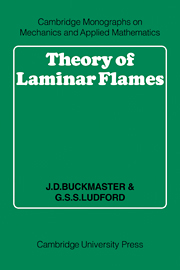Book contents
- Frontmatter
- Contents
- Preface
- 1 Governing equations of combustion
- 2 The premixed plane flame
- 3 Perturbations: SVFs and NEFs
- 4 Steady burning of a linear condensate
- 5 Unsteady burning of a linear condensate
- 6 Spherical diffusion flames
- 7 Cylindrical and spherical premixed flames
- 8 Multidimensional theory of premixed flames
- 9 Burners
- 10 Effects of shear and strain
- 11 Stability
- 12 Ignition and explosion
- Text references
- Further references
- Citation Index
- Subject Index
7 - Cylindrical and spherical premixed flames
Published online by Cambridge University Press: 05 May 2010
- Frontmatter
- Contents
- Preface
- 1 Governing equations of combustion
- 2 The premixed plane flame
- 3 Perturbations: SVFs and NEFs
- 4 Steady burning of a linear condensate
- 5 Unsteady burning of a linear condensate
- 6 Spherical diffusion flames
- 7 Cylindrical and spherical premixed flames
- 8 Multidimensional theory of premixed flames
- 9 Burners
- 10 Effects of shear and strain
- 11 Stability
- 12 Ignition and explosion
- Text references
- Further references
- Citation Index
- Subject Index
Summary
Cylindrical flames
Although it has not been studied to the same extent as the plane premixed flame, the cylindrical premixed flame is (in principle) almost as easy to produce. The reacting mixture is supplied through the surface of a circular cylinder and is induced to flow radially by means of end plates sufficiently close together. The flame then forms a coaxial cylinder that can be observed through the end plates, which should be transparent and good thermal insulators.
Analytically the cylindrical flame lies between the plane and spherical flames. The structure of its reaction zone is the same as that of the plane flame, with temperature constant beyond, so that there is none of the curvature effect of the spherical flame. Like the spherical flame it does not exhibit the cold-boundary difficulty: the mixture must be introduced at a finite radius, which can be so small that a line source is effectively formed. In their attempt to treat curved flames Spalding & Jain (1959) use plane-flame analysis on the spherical flame, where it is never valid, and neglect the cylindrical flame, where it is always valid. The results, however, are qualitatively correct (Ludford 1976).
Sections 2 and 3 show how cylindrical geometry modifies a premixed flame (Ludford 1980). For simplicity we shall consider a single reactant under going a first-order decomposition and take ℒ = 1. Spherical premixed flames, which have many similarities to spherical diffusion flames, will be treated in sections 4–6.
- Type
- Chapter
- Information
- Theory of Laminar Flames , pp. 120 - 135Publisher: Cambridge University PressPrint publication year: 1982

